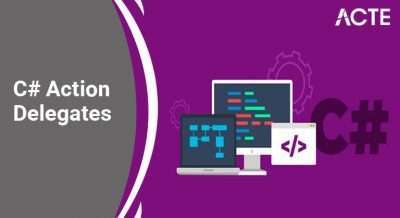
- Introduction to C# Array
- Outline of C#
- Highlights of C#
- Default esteem conduct
- Arrays as Objects
- C# Arrays
- C# Array Types
- C# Arrays Declaration
- C# Arrays Initialization
- C# Jagged Array Declaration
- C# Access Jagged Array Elements
- C# Class
- C# Class Members
- C# Object
- Implicitly typed Array
- Accessing Array Elements
- Uses of Arrays
- Conclusion
- C# is an article situated programming language, and it upholds the ideas of embodiment, deliberation, polymorphism, and so on
- In c#, every one of the factors, techniques, and applications passage focuses are typified inside the class definitions.
- C# is grown explicitly for the .NET Framework, and it empowers software engineers to relocate from C/C++ and Java without any problem.
- C# is a completely Event-driven and visual programming language.
- Microsoft gave an IDE (Integrated Development Environment) instrument called Visual Studio to execute c# programs without any problem.
- C# is an advanced programming language, and it is exceptionally strong, straightforward for building applications.
- C# is helpful in creating windows, web, and gadget applications.
- C# gives programmed memory to the board by clearing unused articles.
- C# is a sort-safe programming language, and it makes it difficult to perform unchecked sort projects.
- C# gives an organized and extensible methodology for blunder location and recuperation.
- C# is a construction situated programming language, and the assemblage, execution of c# applications are quicker because of programmed versatility.
- For esteem types, the Array components are introduced with the default esteem, the 0-bit design; the components will have the worth 0.
- All the reference types (counting the non-nullable), have the qualities invalid.
- For nullable worth sorts, HasValue is set to bogus and the components would be set to invalid.
- int[] numbers = { 1, 2, 3, 4, 5 }; int lengthOfNumbers = numbers.Length;
- Code Optimization (less code)
- Irregular Access
- Simple to navigate information
- Simple to control information
- Simple to sort information and so on
- Single Dimensional Array
- Multi-layered Array
- Jagged Array
- int[] arr = new int[5];//making Array
- int[] arr = new int[5]{ 10, 20, 30, 40, 50 };
- int[] arr = new int[]{ 10, 20, 30, 40, 50 };
- int[] arr = { 10, 20, 30, 40, 50 };
- type[] Array_name;
- In c#, Arrays can be introduced by making an occasion of the Array with another catchphrase. Utilizing another watchword, we can proclaim and introduce a Array simultaneously founded on our necessities.
- Following are the various approaches to proclaiming and instating Array components by involving the new watchword in the c# programming language.
- In the main assertion, we pronounced and introduced a number Array with the size of 5 to permit an Array to store 5 whole number qualities. The Array can contain components from Array[0] to Array[4].
- In the subsequent assertion, we announced and introduced an Array same as the principal explanation and allowed qualities to each file followed by wavy sections { }.
- In a third or fourth assertion, while statement, we instated an Array with values without indicating any size. Here, the size of an Array is not entirely settled by the number of components, so the size initializer isn’t needed assuming that we appoint components during the instatement.
- In c#, we can pronounce a Array variable without introduction, yet we should utilize the new watchword to allocate an Array to the variable.
- In the fifth assertion, we pronounced an Array without introduction, and we utilized another catchphrase to allocate Array esteems to the variable.
- In c#, after a Array statement, we can introduce Array components utilizing list esteems. Following is an instance of announcing and instating Array components involving individual record esteems in c#.
- int[] Array = new int[5];
- Array[0] = 1;
- Array[1] = 2;
- Array[2] = 3;
- Array[3] = 4;
- Array[4] = 5;
- // Jagged Array with Single Dimensional Array
- int[][] jArray = new int[2][];
- // Jagged Array with Two Dimensional Array
- int[][,] jArray1 = new int[3][,];
- In c#, we can get too rough Arra
- int j = jArray[2][1];//50
- int k = jArray1[0][1, 1];//54
- int l = jArray1[1][2, 1];//26
- int I = jArray[0][2];//3ngle or multi-layered Arrays by passing list esteems.
- public class clients {
- // Properties, Methods, Events, and so on
- }
- Clients client = new Users();
- The Array contains a fixed-sized sequential collection of elements of the same type. Arrays are used to store a collection of data, but it is often more convenient to think of an Array as a collection of variables of the same type stored in contiguous locations.
- Instead of declaring a single variable such as number0, number1, …, number99, declare an Array variable such as numbers and use numbers [0], numbers [1], numbers [99]. Represents a single variable. Certain elements in the Array are accessed using the index.
- All Arrays consist of contiguous memory locations. The smallest address corresponds to the first element and the largest address corresponds to the last element. C # Array
- datatype [] ArrayName;
- double[] balance = new double[10];
- Declaring an Array does not initialize the Array in the memory. When the Array variable is initialized, you can assign values to the Array.
- Array is a reference type, so you need to use the new keyword to create an instance of the Array. For example,
- double[] balance = new double[10];
- double[] balance = new double[10];
- balance[0] = 4500.0;
- You can assign values to the Array at the time of declaration, as shown −
- double[] balance = { 2340.0, 4523.69, 3421.0};
- You can also create and initialize an Array, as shown −
- int [] marks = new int[5]
- { 99,
- 98, 92, 97, 95};
- You may also omit the size of the Array, as shown −
- int [] marks = new int[]
- { 99,
- 98, 92, 97, 95};
- You can copy an Array variable into another target Array variable. In such case, both the target and source point to the same memory location −
- int [] marks = new int[]
- { 99,
- 98, 92, 97, 95};
- int[] score = marks;
- When you create an Array, C# compiler implicitly initializes each Array element to a default value depending on the Array type. For example, for an int Array all elements are initialized to 0.
- double salary = balance[9];
- Array stores information components of similar information type.
- Keeps up with various variable names utilizing a solitary name.
- Arrays can be utilized for arranging information components.
- Arrays can be utilized for performing framework tasks.
- Arrays can be utilized for CPU booking.
- The execution of records and vectors, which are a significant piece of C++ STL, is finished utilizing clusters.
- Stacks and line execution are additionally finished with the assistance of Arrays.
- Whenever the situation allows, trees use cluster execution as it is simpler to deal with than pointers.
- Networks significant piece of the numerical library in any programming language-are executed in programs utilizing clusters.
- Nearness list execution of a diagram is done by means of vectors, that thusly, use clusters.
- Any advanced code or program is practically fragmented without the execution of clusters and henceforth however essential, it’s perhaps the main datum structures in any programming language!
Introduction to C# Array
One way is to just announce a Array without instating it with any qualities. The linguistic structure for this is as per the following: type[] Array name; In the above model, type addresses the kind of information to be put away in the Array (or model, string, int, decimal, and so forth).
Outline of C#
Highlights of C#
C# contains different highlights like other programming dialects, for example, c c++ and java. There are a few extra highlights in C# that cause it to vary from different dialects.
Default esteem conduct
Arrays as Objects
In C#, Arrays are really protests, and not simply addressable areas of adjacent memory as in C and C++. Array is the theoretical base sort of all Array types. You can utilize the properties and other class individuals that Array has. An illustration of this is utilizing the Length property to get the length of a Array. The accompanying code relegates the length of the numbers Array, which is 5, to a variable called lengthOfNumbers:
C# Arrays
Like other programming dialects, Array in C# is a gathering of comparative sorts of components that have adjoining memory areas. In C#, an Array is an object of base kind System. Array. In C#, the Array list begins from 0. We can store just a fixed arrangement of components in the C# Array.
Benefits of C# Array
Disservices of C# Array
Fixed-size
C# Array Types
There are 3 sorts of Arrays in C# programming:
C# Single Dimensional Array
To make a single-layered Array, you want to utilize square sections [] after the kind.
C# Array Example: Declaration and Initialization at same time
There are 3 methods for introducing Arrays at the hour of revelation.
We can exclude the size of Array.
We can preclude the new administrator too.
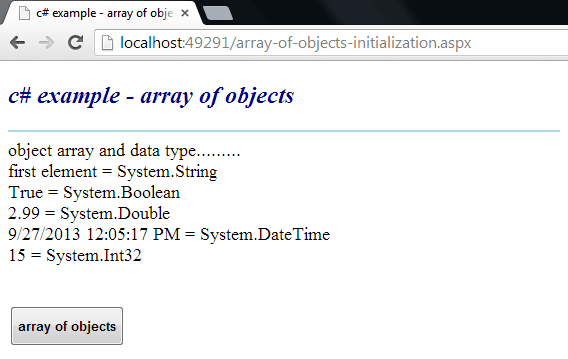
C# Arrays Declaration
In c#, Arrays can be announced by indicating the sort of components followed by the square sections [] like as displayed underneath.
Here, the sort is only an information kind of components to store in a Array, and Array_name addresses an Array’s name. For instance, coming up next are the various approaches to announcing an Array with various information types in the c# programming language.
C# Arrays Initialization
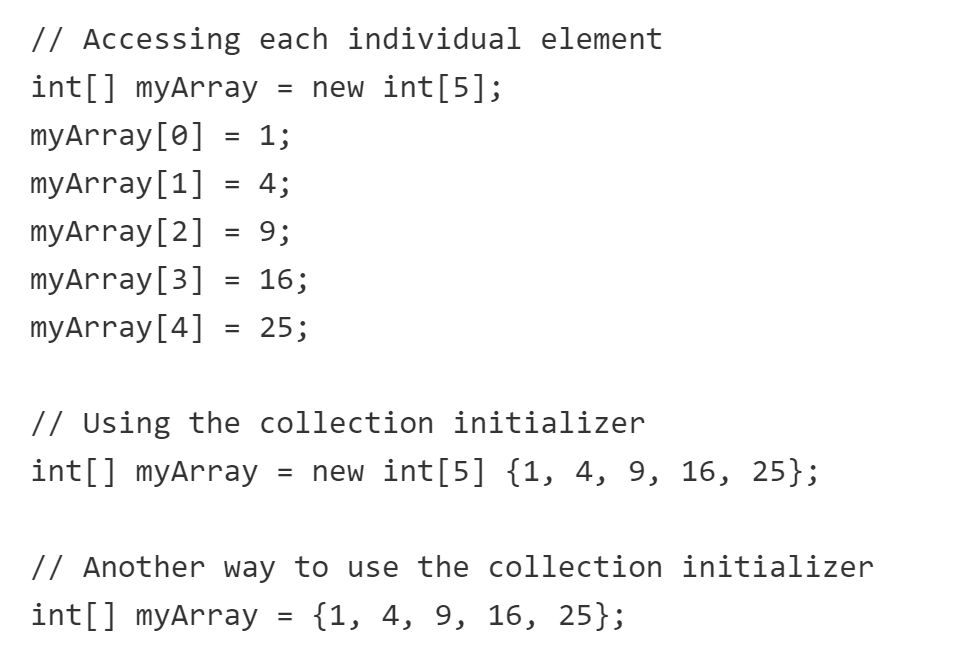
C# Jagged Array Declaration
In c#, a spiked Array can be introduced with two square sections [][]. The primary square section will determine the size of an Array, and the subsequent one will indicate the composition of the Array, which will be put away as a worth. Coming up next are instances of making rugged Arrays in c# programming language with single and multi-layered Arrays.
C# Access Jagged Array Elements
Assuming you notice the above model, we are getting to siys’ qualities by utilizing a line file and section record esteems.
Following is the case of getting to components from rough Arrays in c# programming language in view of our prerequisites.
C# Class
In c#, Class is an information construction, and it will consolidate different sorts of information individuals, for example, fields, properties, part capacities, and occasions into a solitary unit.
Pronouncing a Class in C#
In c#, classes are pronounced by utilizing class watchword. Following is the revelation of class in c# programming language.
Assuming that you notice the above language structure, we characterized a class “clients” utilizing class watchword with a community modifier. Here, the free specifier will permit the clients to make objects for this class, and within the body class, we can make required fields, properties, techniques, and occasions to use in our applications. Presently we will perceive how to make a class in c# programming language with the model.
C# Class Members
As examined, a class can contain numerous information individuals in the c# programming language. The accompanying table records an alternate sort of information individuals that can be utilized in c# classes.
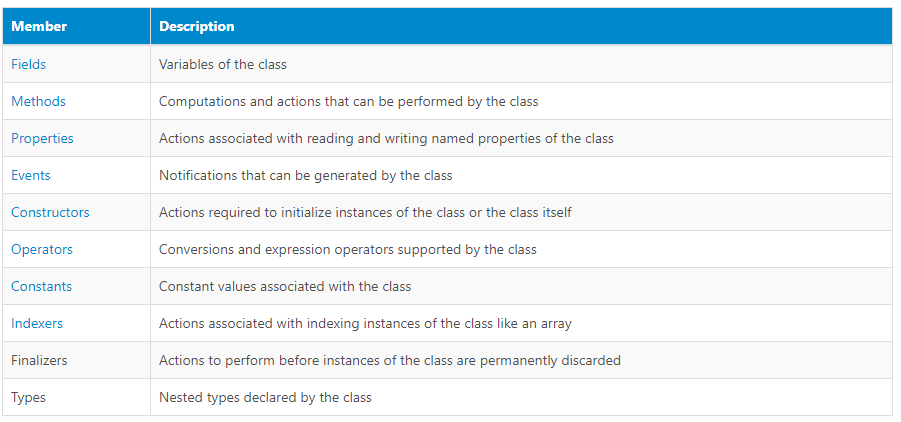
C# Object
In c#, Object is an example of a class that can be utilized to get to the information individuals and part elements of a class.
Making Objects in C#
By and large, we can say that articles are the substantial elements of classes. In c#, we can make objects by utilizing another watchword followed by the class’ name as displayed beneath.
Assuming you notice the above model, we made an example (client) for the class (Users), which we made in the past segment. Presently the example “client” is a reference to an item that depends on Users. Utilizing the item name “client” we can get to every one of the information individuals and part elements of the Users class.
Implicitly typed Array
Declare an Array
You can use the following syntax to declare an Array in C #: −
Data type is used to indicate the type of an element in the Array. [] indicates the rank of the Array. Rank indicates the size of the Array. ArrayName specifies the name of the Array.
Initializing an Array
Assigning Values to an Array
You can assign values to individual Array elements, by using the index number, like −
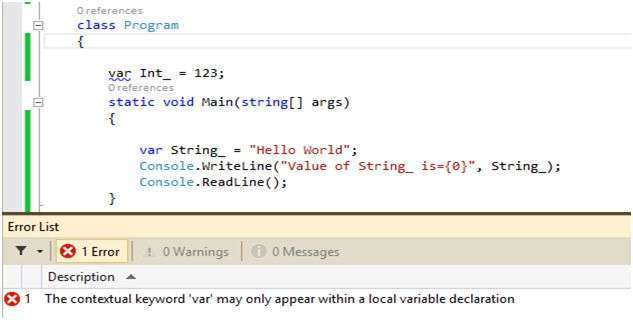
Accessing Array Elements
An element is accessed by indexing the Array name. This is done by placing the index of the element within square brackets after the name of the Array. For example,






